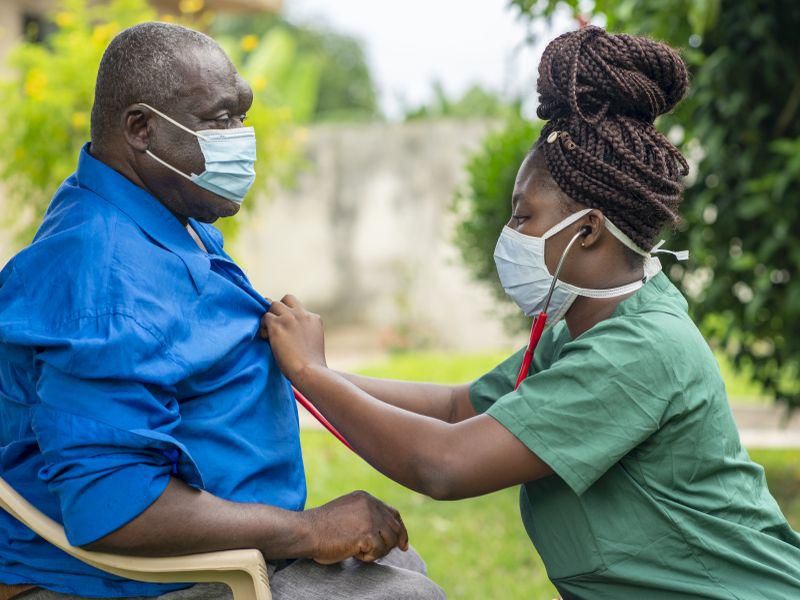TUESDAY, Feb. 16, 2021 (HealthDay News) — U.S. nursing homes have been hard-hit by the COVID-19 pandemic, and the toll on Black and Hispanic residents has been especially harsh, a new study confirms.
Researchers found that COVID-19 death rates were more than three times higher at U.S. nursing homes with the highest proportions of Black and Hispanic residents, compared to those with mostly white residents.
The study, of more than 13,000 nursing homes nationwide, is not the first to document such racial disparities.
But it went farther into the pandemic — mid-September 2020 — and tried to dig for factors to account for the racial divide, said researcher Rebecca Gorges, a postdoctoral fellow at the University of Chicago.
Her team identified two broad patterns that seemed critical: Nursing homes with the most minority residents tended to be larger, and they were often located in counties with more severe COVID outbreaks.
The study could not drill down to the specific reasons those factors might have led to more cases and deaths.
But larger facilities, located in counties with more COVID cases, may simply have created more opportunities for exposure to the virus, Gorges said.
Even though people think of nursing homes as being “locked down,” she noted, the virus can get in the door via staff who were exposed.
That’s why the community prevalence of COVID is believed to be the “key driver” of cases in nursing homes, said Dr. Joseph Ouslander, a past president of the American Geriatrics Society. He was not part of the study.
Nursing home staff are often young, and may come to work with asymptomatic infections, noted Ouslander, who is also a professor at Florida Atlantic University’s College of Medicine in Boca Raton.
Even with facilities screening staff for SARS-CoV-2, he said, cases can slip through in between tests.
It all underscores the importance of containing the spread of COVID-19 in the community at large.
The public, Gorges said, may not realize that their actions to slow the spread — social distancing, wearing masks — can help protect the people most vulnerable to becoming severely ill and dying.
Ouslander agreed. “We all have a social responsibility,” he said.
“Just because you’re not going into a nursing home,” he added, “doesn’t mean you can’t be a source of infections there.”
The findings, recently published in JAMA Network Open, are based on U.S. federal data from 13,312 nursing homes. As of Sept. 13, the facilities reported nearly 335,000 COVID-19 cases and more than 51,600 deaths.
Among the one-fifth of homes with the greatest proportion of non-white residents, 87% had at least one COVID-19 case among residents. That compared with 68% among the one-fifth with the largest proportion of white residents.
Facilities with the most minority patients also saw the most deaths: On average, each home lost just under six residents to COVID-19, while there were just under two deaths per facility among nursing homes with the most white residents.
The study comes at a time when U.S. nursing homes are seeing a glimmer of hope: COVID-19 cases and deaths have reportedly declined in recent weeks.
Over a four-week period spanning December to January, new COVID cases among nursing home residents and staff dropped by more than 50%, according to a recent CNN analysis of federal figures.
It’s possibly, in part, because of vaccinations.
The American Health Care Association and National Center for Assisted Living has said the recent decline was larger at nursing homes that had vaccinated residents and staff.
Ouslander cautioned, though, that at this early point, it’s hard to know what the impact of vaccinations has been. So far, he said, the figures show that while many nursing home residents have been immunized, only a minority of staff have been, as many workers have reportedly been hesitant to receive the vaccine.
“Nursing homes are making progress with vaccinations,” Ouslander said, “but we need to do more to get staff vaccinated.”
More information
The AARP has more on COVID-19 in nursing homes.
SOURCES: Rebecca Gorges, PhD, postdoctoral fellow, Center for Health and the Social Sciences, University of Chicago; Joseph Ouslander, MD, professor, integrated medical science, Charles E. Schmidt College of Medicine of Florida Atlantic University, Boca Raton, and editor-in-chief, Journal of the American Geriatrics Society; JAMA Network Open, Feb. 10, 2021, online
Copyright © 2025 HealthDay. All rights reserved.

